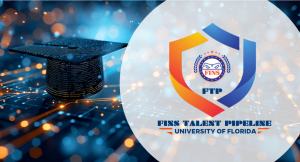Author: Lesly Galiana

Domenic Forte Recognized as ACM Distinguished Speaker
/FINS is proud to share that its Associate Director, Dr. Domenic Forte, has been honored as an ACM Distinguished Speaker. This recognition is part of the Association for Computing Machinery (ACM)’s prestigious program, which highlights individuals who have made extraordinary contributions to computer science, technology, and information security.
Read more »
FINS Celebrates Important Workforce Development Milestone with Graduation of 1st FTP Cohort
/The Florida Institute for National Security (FINS) proudly marked a significant milestone this January with the successful completion of the inaugural cohort of the FINS Talent Pipeline (FTP) Program. The conclusion ceremony, held on campus on the 17th, celebrated not only the achievements of the students but also FINS’ commitment to meeting its mission of producing a talent pipeline of AI and data science-knowledgeable professionals in support of national security.
Read more »
FINS Talent Pipeline Program Featured in UF News
/FINS’ Talent Pipeline (FTP) Program continues to garner attention across campus and beyond.
Read more »
FINS EPA with NSA
/The University of Florida (UF) has entered into an Education Partnership Agreement (EPA) with the National Security Agency (NSA). The partnership will seek to enhance Science, Technology, Engineering & Math (STEM) education at UF by enabling technical exchanges, as well as the sharing of educational materials and equipment between the two entities. Moreover, as a result of this agreement, any UF student or faculty would have access to a wide pool of resources and expertise – all while gaining invaluable work experience.
Read more »
FINS Faculty Op-Ed: “GenAI is transforming higher education, and Florida is leading the way.”
/In a recent Tampa Bay Times article, FINS faculty, Dr. Sid Dobrin, weighs in on the impact that Generative Artificial Intelligence (GenAI) is having on higher education and how Florida colleges and universities, including the University of Florida (UF), are embracing and guiding its implementation, thus playing a pivotal role in ushering in the coming AI-savvy workforce.
Read more »
FINS Faculty Play Pivotal Role in New Cybersecurity-Focused IARPA Project
/FINS faculty, Dr. Bonnie J. Dorr and Sonja M. Schmer-Galunder, are among the recipients of a new, large, multi-institutional award from the Intelligence Advanced Research Projects Activity (IARPA) agency – the research arm of the Office of the Director of National Intelligence- that delves into the psychology of cyber attackers.
Read more »
FINS Talent Pipeline Program: Pioneering the Future of National Security and Defense Research
/The FINS leadership team “is an integral part of a groundbreaking $992,000 initiative at UF called Charting the Course to Preeminence in National Security Leadership.”
Read more »
